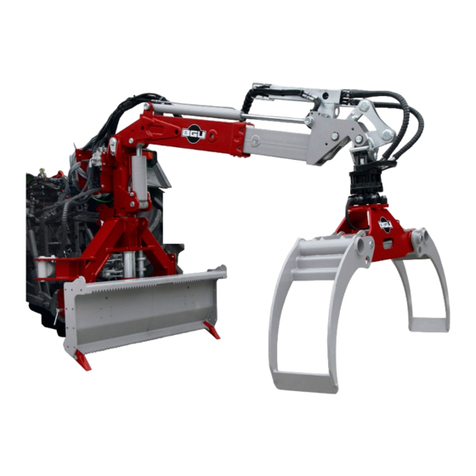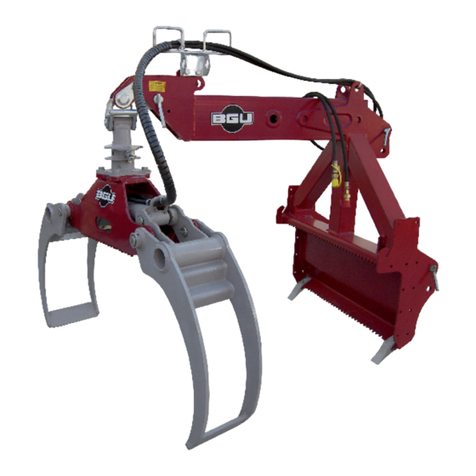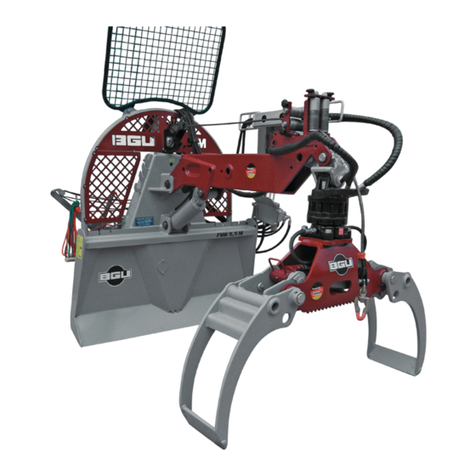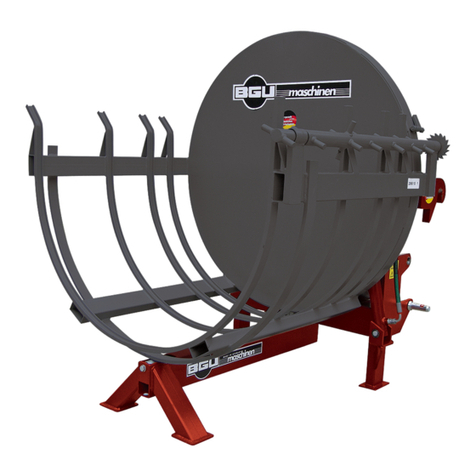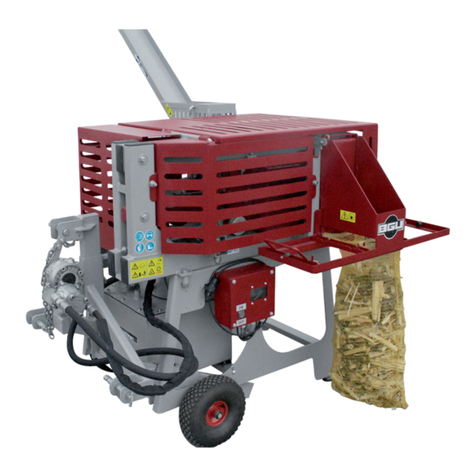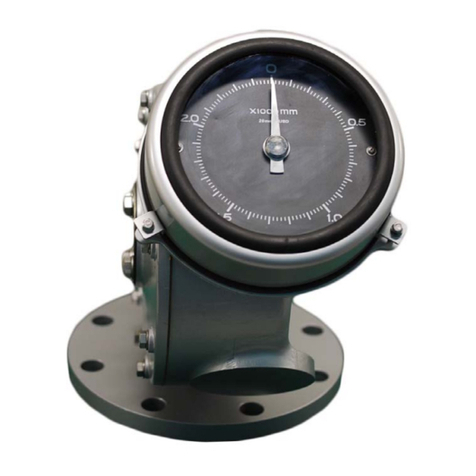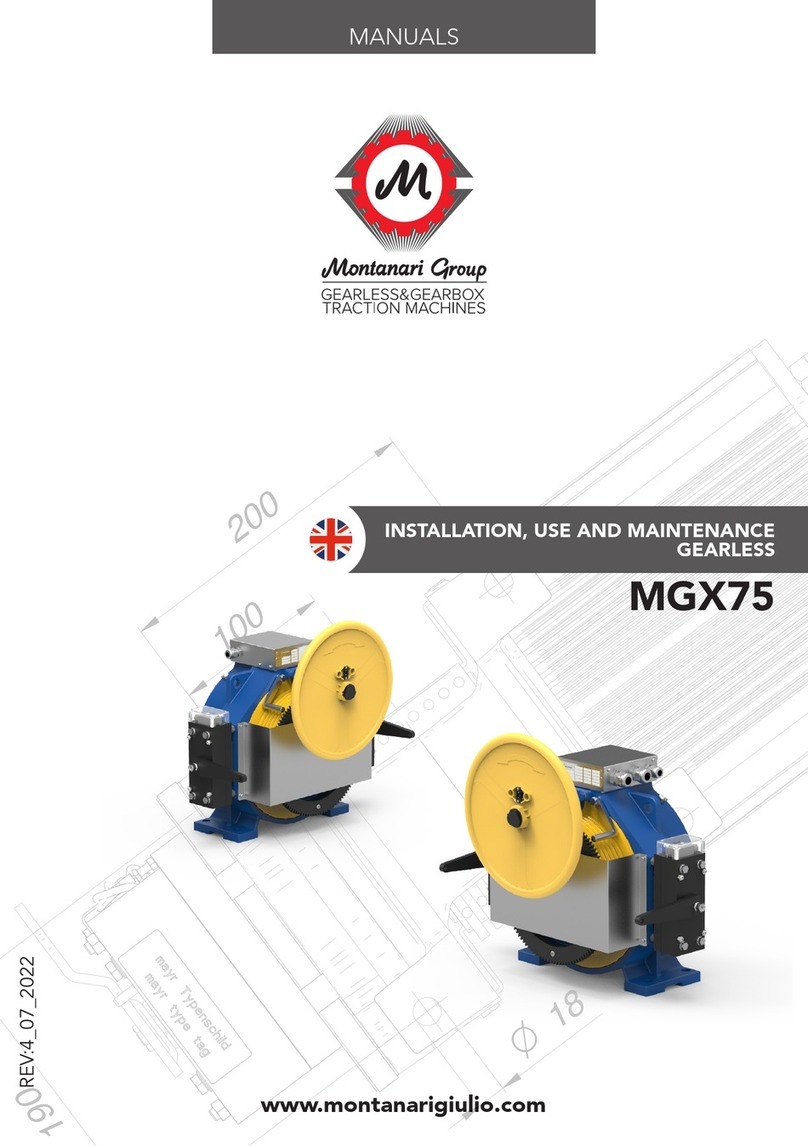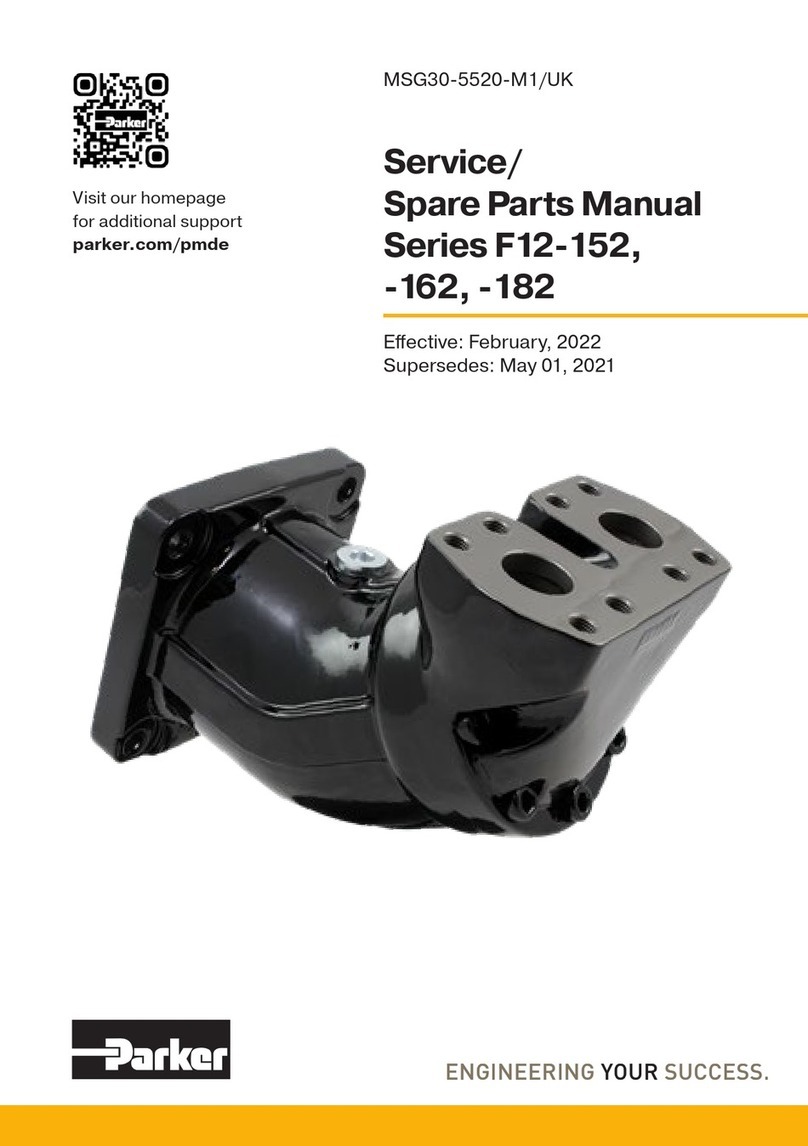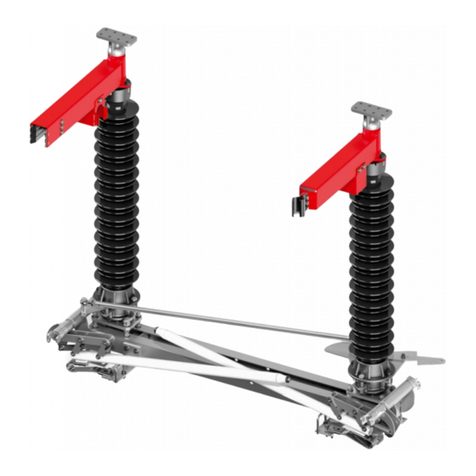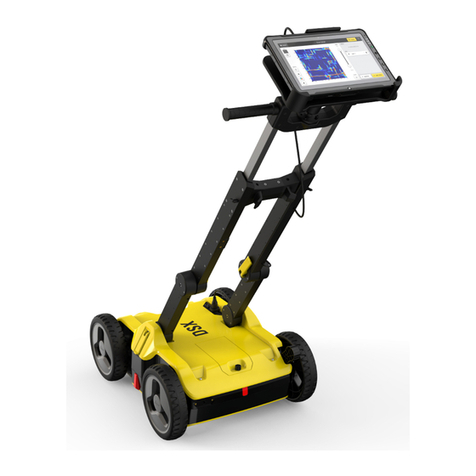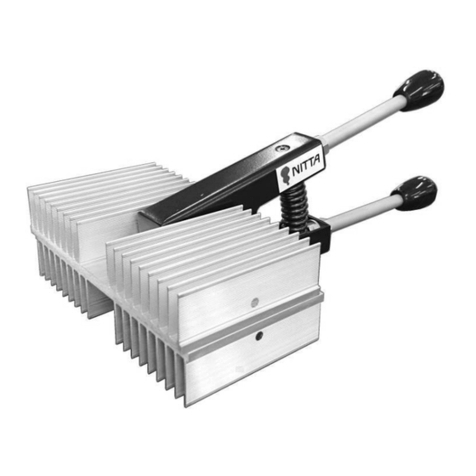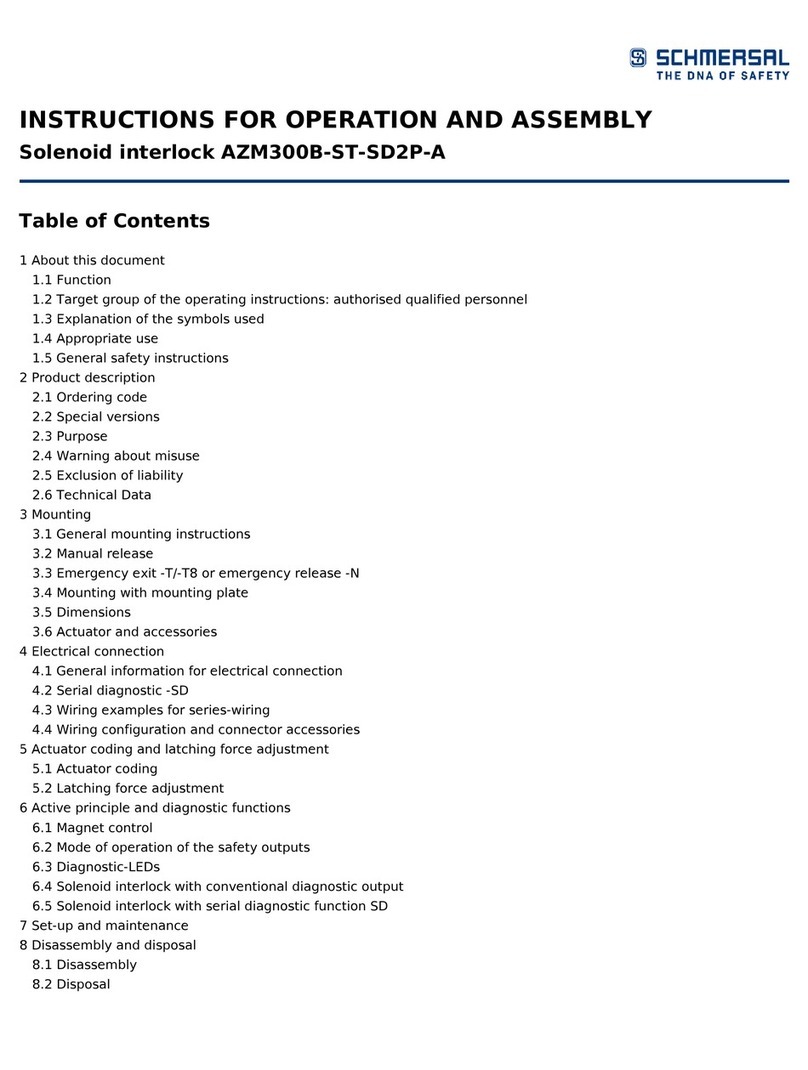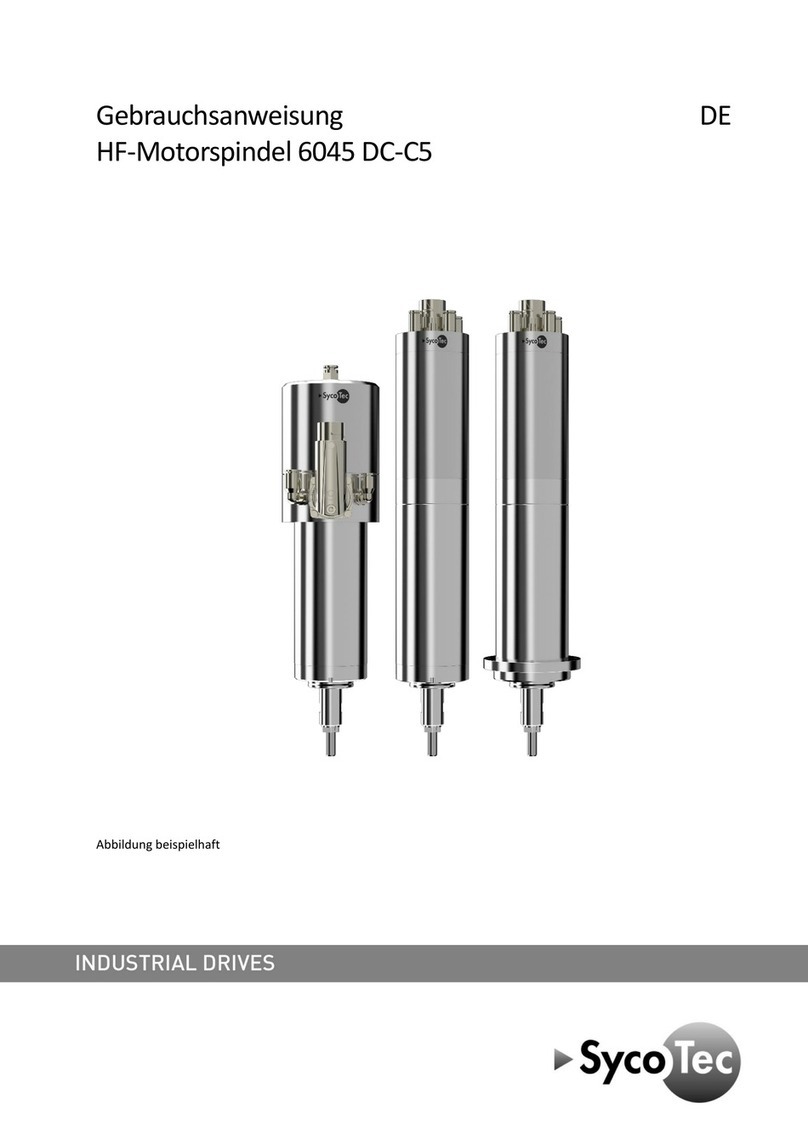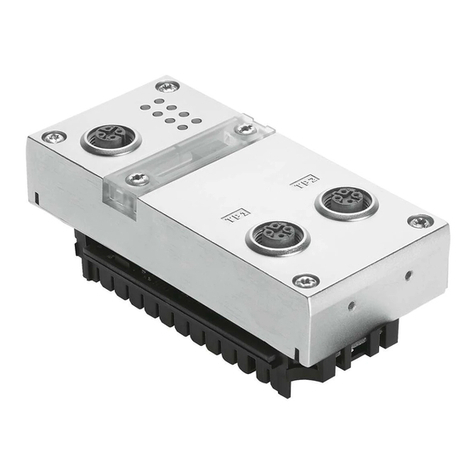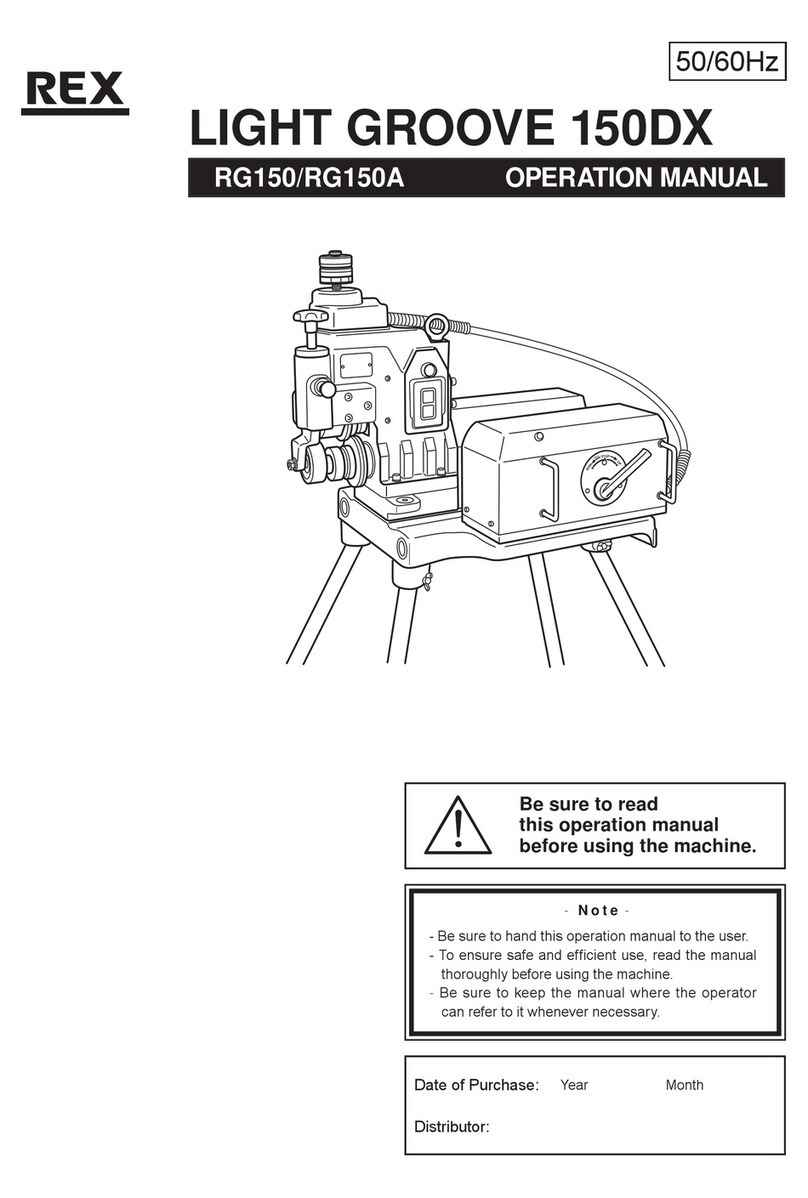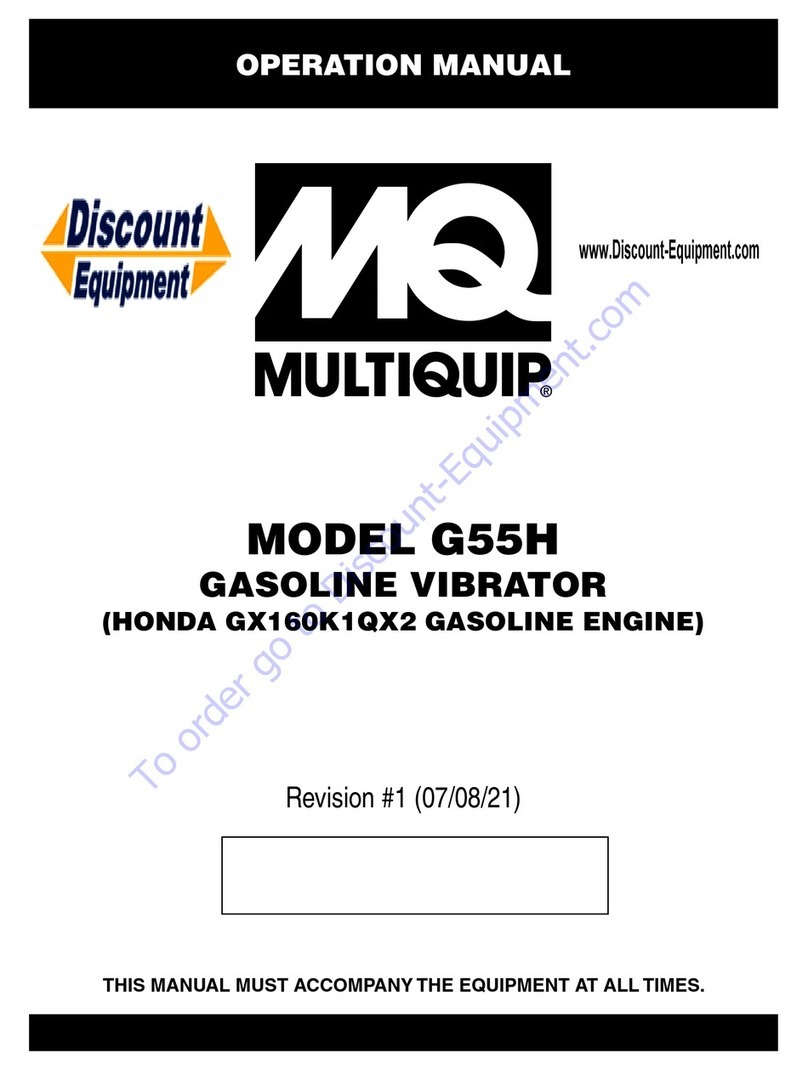BGU HRZ FIX Euro/Kombi User manual

USER MANUAL
Carefully read these instructions before starting
and using your log loader!
HRZ FIX Euro/Kombi
Südharzer Maschinenbau GmbH
Helmestraße 94 ∙ 99734 Nordhausen/Harz
Receptionist: 03631/6297-0 6297-111
Internet: www.bgu-maschinen.de
e-mail: [email protected]
We manufacture
in Germany!
- Set-up & installation
- Use
- Maintenance
- Accessories

2
CONTENT
Content 2
1. General information 3
1.1 About this manual 3
1.2 Delivery and transport claims 3
2. Safety pictograms and warning labels 5
3. Safety 7
3.1 General safety rules and occupational safety 8
4. Operation 10
4.1 Mandatory application field 10
4.2 Preliminary controls before use 10
4.2.1 Mounting the loader to the tractor 10
4.2.2 Assembling an additional control valve unit 11
4.3 Start-up 11
4.4 Attachments 12
5. Hydraulic system 13
6. PTO-powered operation 13
7. Repairs and maintenance 14
7.1 Ordinary maintenance 15
8. Transport & handling 15
9. Dismounting and discarding an obsolete loader 16
10. Technical specifications 17
11. Other areas of possible hazards 18
11.1 Mechanical dangers 18
12. Warranty 18
13. Spare parts list for HRZ Fix-Euro/Kombi 19
13.1 Spares for log grapples model 1300 20
13.2 Spares for log grapples model 1700 (optional) 22
13.3 Spares for top slewing arrangement (optional) 24
13.4 Spares for bucket assembly model 1500 (optional) 25
13.5 Spares for pivotal hanger for claws rotation 26
13.6 Spares for rotator (Optional) 27
14. EC Statement of compliance 29

3
Dear customer, thank you very much for your trust and preference in
choosing our equipment and joining the number of our best customers
in the world. We are confident that our equipment will be up to all your
expectations and assure you a long lasting quality and performance.
1.1 About this manual
Please take time to read this manual and learn to how operate and
maintain the equipment safely.
For your easier reading this manual is laid out in several sections. The
sections are progressively numbered 1 through 14 and listed on the
“content” page.
The information, pictures and technical data in this document reflect
current or planned product features, functions, and characteristics as
of the publication date. Because of on-going product improvement and
feature additions, information in this document is subject to change
without notice.
If you are experiencing a problem or functional trouble on your equip-
ment, please read the “trouble-shooting” section to identify possible
causes and remedies.
When you have checked all the possible causes listed and you are
still experiencing the problem, ask your Authorized Service Centre for
help.
When you order parts for maintenance or repair services, your Autho-
rized Service Centre, your dealer or eventually the manufacturer need
your machine serial number and engine serial number. These are the
num-bers that you have recorded on the product identification label of
the manufacturer on the machine.
1.2 Delivery and transport claims
Upon delivery of the machine please check for visual machine dama-
ges such as broken packing or scratched buckled parts. If so, make a
remark on all copies of the delivery bill (including the one for your own
use) before signing for acceptance.
Should your shipper or the truck driver refuse to accept your claim and
countersign the delivery bill, fully reject delivery and make sure to in-
form us (the manufacturer) immediately. No claims shall be taken into
account by the shipper or by the insurance company, if a reservation
note is not made on the delivery bill.
1. GENERAL INFORMATION

4
All transport damages must be notified within latest 2 days from de-
livery. Therefore delivery must be collected and inspected within this
term. Later claims shall be disregarded. In case of assumed but not
visually clear transport damages make sure to mark the following sen-
tence on the delivery bill: „Reserved delivery due to assumed trans-
portation damages“.
Insurance and shipping companies act with extreme caution in case
of transport damages and sometimes refuse to accept responsibility.
Please make sure to provide clear and exhaustive evidence (photos)
of the claimed damages.
Thank you in advance for your help and understanding in this matter.

5
1. Pictogram: „Grapple Release/Grasp“
2.
Pictogram „Hydr. Motor“
3. Pictogram „Swivel Arm to the right/left“
4. Pictogram „Extendible Arm, Retract/Extend“
5. Pictogram „Retract/Extend Upper Pin“
6. Pictogram „Pivotal Hanger UP/DOWN“
8. Pictogram „Boom Lift UP/DOWN“
8. Machine safety label
„Read the instructions before start-up“
Read, understand, and follow all instructions in this manual and on
the machine before starting!
2. SAFETY PICTOGRAMS AND WARNING

6
9. Identification label „Product identification“
This label shows the company details of the manufacturer and the
main machine technical data.
10. „BGU-Maschinen“ Manufacturer‘s Logo
11. Safety pictogram
„Do not infringe the dangerous zone“
Avoid standing in the dangerous zone between the tractor and the log
loader.
12. Safety pictogram
„Danger Pinch Point“
Keep hands away from this danger zone till all moving parts have
come to a complete stop.
13. Safety pictogram
„Caution: operating zone“
Stand clear: do not allow bystanders in the dangerous operation area
while the machine is at work.

7
Strictly perform installation, set-up, maintenance, cleaning
and transportation with the engine switched off and all moving
parts firmly secured against accidental operation. Immediately
disconnect power off the machine in case of any eventual fault
or trouble.
The user shall strictly comply with these operation, set-up, mainte-
nance, repair and trouble-shooting instructions in order to assure safe
operation and no damages to the equipment. Moreover we recommend
to let the machine be run and maintained strictly by trained and skilled
staff who must be familiar with the applicable occupational safety and
health administration rules as well as applicable transportation rules.
Incorrect use of the saw can cause serious injury or death.
No person under school leaving age should operate a log loader. Those
who have reached school leaving age but are below the age of 18 may
operate a log loader if supervised by a competent person of 18 years
or over. The machine shall be installed and kept in a suitable location
selected by the customer for safest operation.
Make sure that the equipment stands on a safe stable foundation.
Do not allow within the hazardous zone any unauthorized third or per-
sons who are not familiar with the dangers related to use and opera-
tion of the machine. Allow no bystanders, especially children and pets
in the working area.
• Log loaders are not designed for passangers transportation.
• Strictly control/operate the log grapples from the driver‘s seat on
the tractor.
• Do not allow any thirds in the dangerous zone. The dangerous zone
includes the swivel/rotation area as well as the bucket and grapples
operation (grasp/release) area. Provide due clearance around the
log/timber handling zone.
• Make sure to firmly close the clamp and park it across travel
direction when at rest.
• Make sure that the grapple is hanging free so that slewing to both
sides is possible during travel on uneven ground/terrain.
• When you pull/hand timber always keep in mind that lurching or
other sudden, flicking movements of a suspended/pulled load may
occur due to timber flexibility and bounciness. Mind for the safety of
your fellow workers and take due measures to keep the work area
free from other thirds and obstacles. Maintain safe distances
from other ground workers and equipment units.
3. SAFETY

8
• Perform logs piling and general rolling operations with extreme care
and at very low tractor speed. DANGER: watch for timber/branches
that may fall on or enter the operator’s compartment.
• Changing the length setting of the extendible arm may be strictly
performed with the butt plate lowered on ground, the grapple
clamped and the tractor engine switched off. Also make sure to
disconnect the hydraulic system and protect it against accidental
restart.
• When travelling across a slope or turning around a bend with a
suspended load, always maintain a low gear to avoid any danger to
the tractor in the event of possible skidding, jamming or canting of
a log and consequent dangerous rollover.
• Immediately repair or replace eventual faulty hydraulic components.
• Do not let hydraulic pressure hoses lay unprotected in the driver‘s
cabine after installing and connecting the control valve unit (control
slide valve / electric valve).
• Always wear suitable protective gloves when doing works on the
hydraulic system. AVOID HAND CONTACT with hydraulic oil.
• BEWARE: a log grapple attached to a U-joint cannot be firmly laid
down on ground. To avoid the grapple from rolling over or getting
tangled, make sure to secure it before laying down.
• Before replacing or servicing the grapple hanger, secure the clamp
against fallover and make sure to strictly grasp the clamp from the
sides. DANGER of legs/feet injuries.
• Pinch points will occur any time when converting from fixed to
mobile grapple attachment. BEWARE: injured fingers danger.
• If you are using a winch, account for a dangerous area same as at
least the length of the rope. Keep this area free from bystanders
and unauthorized thirds.
• A rescue/emergency kit for drivers and team safety are mandatory
and must be always available in the driver‘s cabin.
3.1 General safety rules and occupational safety
• Before each new use, check for your tractor operational and road travel safety!
• Mind for all safety pictograms and operation labels on your grapple
loader. They are all-important for safe operation and travel!
• Before starting with loading operations, familiarize with all safeties and
controls on your equipment and with their functions. Do not expect to
learn as you practice. Grapple loaders are heavy-duty equipment requi-
ring preliminary training!
• Operators must wear steel toe safety shoes and snug-fitting, tear-resistant work cloths.
• Keep the equipment as free as possible of accumulated limbs and
debris, to avoid any fire danger!
• Know where crew members are at all times. Be alert to unexpected
workers or operations in the immediate skidding area. Before starting
the tractor and beginning to work, make sure that there are no bystan-
ders (especially children) in the surroundings. Be cautious of blind spots
around the loader where the operator’s visibility is limited!

9
• Do not allow anybody on the loader during loading or travel opera-
tions!
• Connect the equipment in compliance to these instructions and the
applicable provisions!
• Work defensively. Think ahead and anticipate hazards. Take special care
in connecting/disconnecting eventual attachments to/from the tractor!
• Always have the unit firmly stand on the special outriggers when
performing mounting/dismounting works on the machine! (safety
and stability)
• Never overload a machine. Carry a load that is safe, within the capacity
of the machine, and suitably secured in the special fixation points on the
machine!
• Always comply with the admissible axis loads and transport
dimensions/clearance!
• Provide and check the functionality of all transport facilities as for instance
illumination, warning tools and devices, safeties and protections!
• The disconnectors of the quick-action couplings must hang loose.
Avoid self-disconnection in the lower section!
• Never leave the operator‘s stand during travel!
• Travel, steering and braking performance are affected by the use of
hanging ballast on the machine. Always keep at safe distance for
steering and braking!
• When taking turns please mind for both the outreach and/or rotating
mass of the equipment!
• Make sure that all safeties and protections are duly in place and
operating before starting to use your equipment!
• Strictly start log loading operations when all workers are clear of
the area!
• Keep the turning/slewing area of the equipment clear from any obstacle!
• Make sure that no persons and no obstacles are within the slew range
before operating any of the hydraulic folding frames.
• BEWARE of pinch hands danger on all moving parts (for instance
hydraulic attachments)!
• Always keep at safe distance from any manually folding/flapping
attachments!
• Before leaving the tractor, make sure to lower the grapple down on
ground, switch the engine off and remove the keys from the ignition!
• Make sure that no persons stand in the dangerous zone between
the tractor and the trailer unless due measures were taken to prevent
the vehicle from rolling away (for example engaging the parking
brakes and using additional wheel chocks for increased safe)!
• Folded frames and telescoping hoisting devices must be duly
secured in the transport position!

10
4. OPERATION
4.1 Mandatory application field
Grapple loaders are strictly designed for woodlot owners to pull, handle
and manipulate timber logs. They are purposely designed with attach-
ment lungs to allow for very practical pulling operations by means of log-
ging chains. The maximum working pressure of the grapple is 180 bar.
The rotator motor is equipped with standard built-in pressure relief
valve set by manufacturer at 170 bar so that no further adjustments
are required by operators on site.
This loader is available in the following versions: HRZ FIX-EZ, HRZ
FIX, HRZ FIX-AS, HRZ 180, HRZ LADER, HRK, HRZ FIX EURO
Suitable for tractor power up to: 80 (90) PS
DO NOT ATTACH THE LOADER to more powerful tractors. DANGERS of
even permanent loader damages.
Make sure that a suitable forestry/rescue kit is available in the driver‘s
cabin at all times and take due measures to ensure safety of the tractor
driver during all operations. If you are attaching a winch to your equip-
ment, mind for user instructions of the winch manufacturer too.
Any other application (i.e. handling loads off any higher level than
the surface on which the tractor stands whenever the load exceeds
the capacity of the tractor inbuilt hydraulics) will be considered as
misuse and is therefore strictly prohibited!
4.2 Preliminary controls before use
4.2.1 Mounting the loader to the tractor
• Attach the equipment to the three-point linkage of your tractor
using the 25 mm pins and cotters supplied by the manufacturer
with the loader.
• Connect the hydraulic hoses of the loader to your tractor hydraulics.
• Provide for best linkage to your tractor making use of the most
convenient hitching points out of the ones available on the loader.
• Use your tractor hydraulics to pull and then gradually lift the loader
up. When lifting from the front the lift boom will go so far down that
the cab might get damaged. Risk of getting jammed! Work with
extreme caution.
• Install the extendible arm acting in strict compliance to A (see
safety tips)

11
Südharzer Maschinenbau GmbH will accept no liability for the state
and conditions of your tractor three-point linkage. Make sure to install
the loader so that no damage can occur to the driver‘s cab during off-
road travel or with lifted hydraulics.
4.2.2 Assembling an additional control valve unit
As soon as a hydraulic function is no longer required, you can use it to
control operation of the hydraulic upper link.
Hand control valve
• Install on a convenient mount inside the tractor cab
• Properly connect all hoses. WARNING: an inverted flow direction will
lead to control valve failure
• Never remove the check valve from the drain line
• Impress all operating symbols
Hand control valve - symbols
A symbol is impressed/labelled in the back/front of each joystick to
show the respective corresponding loader functions. (see point 2 of
the safety instructions)
4.3 Start-up
Operating instructions
• Perform hydraulic operations while seated in the machine: never
from the ground.
• Always set the top grapples and the rotator on the float
position of the control valve before starting to winch heavy trunks.
• Know where crew members are at all times. Be alert to unexpected
workers or operations in the immediate dangerous/loading area.
• Do not use the grapple to handle trunks that are smaller than 8 cm
in diameter unless you can bundle and lift them together.
• To assure trouble-free braking and steering of the loader travelling
with a suspended load, at least 20% of the vehicle own weight shall
still be arranged on the on the front axle. The exact amount of ballast
weight that one can use, must be obtained from your tractor supplier.
• Travel performance much depends on the ground/road conditions
and the attachments to our equipment. Always drive cautiously and
defensively minding for your route at all times.
• When not in operation, always lower the boom and rest the grapple
on the ground or on the special carrier designed for accomodating
the grapple.

12
• Check the fixation bolts and the respective cotter pins before start-up.
• Close the grapple and set it across travel direction before operating
the unit without a load (unloaded state).
Close the grapple and position it across the travel direction when tra-
velling without a load. DANGER! Travelling with open grapples may
induce even permanent damages to your grapples.
Use rigid or movable grapple suspensions depending on the type of
timber to be handled.
• Rigid suspensions are not recommendable for hardwood that may
damage the loader or the tractor during travel under certain severe
conditions.
Eventually use a top slewing arrangement if required by the working
conditions on your site.
• Top slewing arrangements should be used every time when hand-
ling of huge timber or entire trees comes into question. In this special
operation mode, the weight of the transported load is a crucial feature
and should be given extremely accurate consideration.
• If you are winching heavy trunks, be sure that the floating mode
is selected on the control valve block for the rotator and the slewing
system.
4.4 Attachments
• Before mounting and dismounting any attachment to/off the three-
point hitch, adjust the related operating controls so to avoid any acci-
dental raising/lowering.
• Make sure to attach the loader to a tractor of required power and
hitching specifications!
• Typical injuries resulting from getting caught in a three-point-hitch
are amputations, lacerations and pinch hands. Account the 3-point
hitch as a dangerous area and move cautiously around it!
• Never stand between the tractor and the loader when using three-
point linkage external operation!!
• While setting the equipment in its transport position always provide
for sufficient side detent of the three point hitch!
• While travelling on road with the raised loader, always secure the
control levers against accidental shifting down!

13
5. HYDRAULIC SYSTEM
• DANGER: the hydraulic system operates at very high pressure!
• Mind the correct connection of all hydraulic hoses, as you perform
branching of the hydraulic cylinders and of the motors!
• For due connection of the hydraulic hoses to your tractor hydraulics make su-
re that no pressure is available on both the tractor and the attachment side!
• For connection of hydraulic loader functions to the tractor make sure
to mark both the coupling sleeve and the relevant connector so that
no accidental faulty controls can occur! Hydraulic misconnections may
lead to dangerously inverted functions (i.e. lifting instead of lowering)
and consequent risk of very severe accidents!
• Perform regular inspection of all hydraulic lines and immediately replace any
defect or old tube/hose! Replacement hydraulic components must comply with
the technical specifications of the original parts supplied by the manufacturer!
• Check the state of all hydraulic hoses, fittings and connectors and
seal eventual leaks, if required. Do not check for leaks with your
hand. Leaks can be located by passing a piece of cardboard or wood
around the suspected leak and looking for discoloration.
• High-pressure fluid (oil) escaping from a very small hole can be al-
most invisible. Escaping fluid under pressure can have sufficient force
to penetrate skin, causing serious injury or even death! In this case
seek immediate doctor help! (danger of infections)
• Make sure that the machine is fully disconnected and all moving parts are
secured before performing any maintenance/repair work on the machine.
• Worn-out and slacked safety chains will hang out! (the cylinder
must be filled with oil)
6. PTO-POWERED OPERATION
• Strictly use certified and approved drive shafts and assure strict
compliance to the manufacturer’s instructions for use and assembly!
Never switch drivelines among different machines.
• The entire drive shaft is a wrapping point hazard if it is completely
unshielded. Make sure that all guards and shields of both your drive
shaft and the PTO-stub (master shield) are in good state and duly as-
sembled in their place before starting to work!
• Ensure that the closed and extended length of the guard and the drive shaft
are right for the tractor and machine in both its transport and operating asset!
• Stop the engine (pull the keys out), securely park the tractor, set
the brakes, disengage the PTO and shut off the tractor before moun-
ting/dismounting the drive shaft!
• Periodically check that your drive shaft is securely mounted and connected!
• Ensure that a restraining device, eg a rope or chain, is in place to
prevent the guard rotating with the shaft!
• Before engaging the PTO ensure that the tractor PTO speed matches
with the admissible rpm of the loader!

14
Make sure that the machine is fully disconnected and all moving
parts are secured before performing any maintenance/repair work on
the machine. In the event of any malfunctioning, switch the machine
off before trouble-shooting.
Completely open the grapples tines and lower the grapple on ground.
Disconnect the tractor (or other towing vehicle) before starting any
repair or maintenance work.
Beware: a loader with the grapple pivotally connected to a universal
joint (pivot) will stand at tilt-over risk unless it is firmly supported and
secured against collapsing.
• Provide immediate replacement of defective hydraulic lines and cou-
plings or other hydraulic components.
• Rust, dirt and crop debris must be cleaned frequently to allow the
piston rod of both the grapple cylinder and the slewing cylinder to
operate trouble-free.
• Keep the log fork and the grapples tines clean.
• Periodically ensure best state and functionality of the electric system.
• Remove and replace worn-out or unreadable pictograms and labels.
• While PTO-powering your loader, ensure that the number of PTO-
shaft rpm matches the travel speed and that the direction of the revo-
lution changes while performing backward travel!
• Do not engage the PTO without priory switching the engine on!
• Never step across a rotating PTO driveline. Keep the area around a
rotating PTO/driveline always clear from bystanders!
• Don’t turn too sharply as this could cause the lower links or tractor
tyre to foul the PTO drive shaft. Always disengage the PTO drive when
making wide-angle turns.
• Beware of the residual centrifugal mass when you disengage the PTO shaft!
• Wait for all movement to cease before approaching the dangerous
area of the PTO drive or attempting to clear any blockage!
• Disengage the PTO, shut off the tractor and remove the keys before
dismounting to clean, repair, service, or adjust machinery!
• Ensure that there are no persons standing between the tractor and
the implement before engaging a PTO drive.
• For your own safety and the one of your co-workers always keep unau-
thorized people away from the dangerous area around the machine.
• Always hang an uncoupled drive shaft to the special bracket!
• Protect the tractor PTO with a shield covering the top and both sides
of the PTO so that it stops anyone making contact with it after uncou-
pling the drive shaft!
• Broken, damaged or badly fitting guards can be just as dangerous as no
guard at all! Eventual anomalies must be fixed before starting to work!
7. REPAIRS AND MAINTENANCE

15
7.1 Ordinary maintenance
The following services must be provided at 10 hour operation intervals:
• Lubricating all moving parts by means of the respective nipple head
• Recommended lubricant: universal lub grease
• Lubricating the extendible load lifting arm using a grease brush
• Check the conditions of all hydraulic couplings and hoses
• Tightening all screwed/bolted joints, checking and replacing
eventual missing hardware.
8. TRANSPORT AND HANDLING
A switched-off loader stands at instability risk as the grapple keeps
hanging pivotally on the universal joint.
Always secure the loader against tipping over, folding up and/or col-
lapsing.
Make sure to close the grapple and set it across travel direction prior
to rolling without a load.
DANGER: failure to comply with this instruction may lead to grapple
damages!

16
When the machine is fully obsolete and cannot be of any longer use,
it should be duly dismounted ahead of discarding. Certain components
need deactivation and dismantling in order to assure that no further
use is made by other parties and that no worn out parts are recycled
for other applications.
During dismantle be alert for possible recyclable materials and com-
ponents that belong to differentiated waste collection procedures ap-
plicable in your country.
The manufacturer is not liable and undertakes no responsibility for
personal injuries or damages that may result from the recycling of
worn out machine parts and eventual reuse in other applications diffe-
rent than originally stated in this manual.
Dismantling procedure:
Take good note please: each and every dismantling task must be per-
formed by authorized service centres or trained skilled staff only!
• Pull the machine down into single components
• Lock and clamp all moving machine parts
• Deliver each single component only to authorized waste manage-
ment facilities
• Drain oil and fuel out of respective tanks and lines before disposal of
the machine
• Remove rubber and plastic parts from the machine that must be se-
parately disposed of
Deactivated, clamped moving/driving parts and components are of no
further risk and danger.
9. DISMOUNTING AND DISCARDING AN
OBSOLETE MACHINE

17
Technical specification Unit of
measurement
Attaches to any front-mount or to a
rear, Category II three-point hitch
Tractor power requirement KW 40 - 90
Grapple model HG 1300
Max gripping width
Clamping force
mm
t
90-1280
9,5
Grapple model HG 1700 (optional)
Max gripping width
Clamping force
mm
t
90-1680
9,5
Weight without optional
accessories
kg 248
Optional rotator
Weight
Nm
t
kg
850
4,5 at 195 bar
25
Length w. hoses mm 1600
Width mm 1100
Width w. bucket (optional) mm 1550
Height w. grapple mm 1200
Transport height mm 1000
10. TECHNICAL SPECIFICATIONS

18
11. OTHER AREAS OF POSSIBLE HAZARD
11.1 Mechanical dangers
Possible dangers related to machine moving parts are minimized by
means of suitable safeties and protections that cannot be removed
unless special tools and equipment are used. Do not attempt to remo-
ve or by-pass any of the machine inbuilt safeties.
DANGER: removing or by-passing inbuilt machine safeties may result
into serious operator’s personal injuries.
12. WARRANTY
All our machines are covered with warranty terms in accordance with
the law. Customers should promptly notify the manufacturer eventual
material or production claims on their detection. While asking for war-
ranty service, customer should show copy of their purchase invoice or
receipt. The warranty does not cover for faults due to natural wear,
temperature or weather agents as well as misuse, faulty installation
or set-up, improper operation and lubrication or acts of vandalism.
No warranty will be given on parts damaged by improper handling,
use and application. The manufacturer is further not responsible for
warranty service on machines used for other applications than menti-
oned in this manual, altered or modified by the customer or other
thirds, or overloaded. Never attempt to use an incomplete machine or
one fitted with unauthorized modifications. Any modifications to your
machine can cause personal injuries, and will void your warranty.
Consumable parts with a prescribed life (i.e. pulleys, tools, blades and
various auxiliary materials) are excluded from the warranty as well as
adjustment, optimization and fine-setting or retrofitting works.

19
13. HRZ FIX-EURO/KOMBI, SPARE PARTS LIST
Pos.
Description
Number of
pcs.
Art. Nr.
1BG hose, fairlead
1 22820
2BG frame Euro Kombi
1 22256
3Category 1, lower link pins
6 55994
4Clamp hanger
1 22387
5Upper link pins
1 55991
6Grapple HG 1300
1 23842
7BG standard pin 30-123
1 22829
8BG Joint
1 22335
9BG Fastening bolt
1 22833
10 BG standard pin 40-120
1 22835
11 BG Outrigger
2 23890

20
13.1 Grapple 1300, Spare Parts List
Table of contents
Other BGU Industrial Equipment manuals
Popular Industrial Equipment manuals by other brands
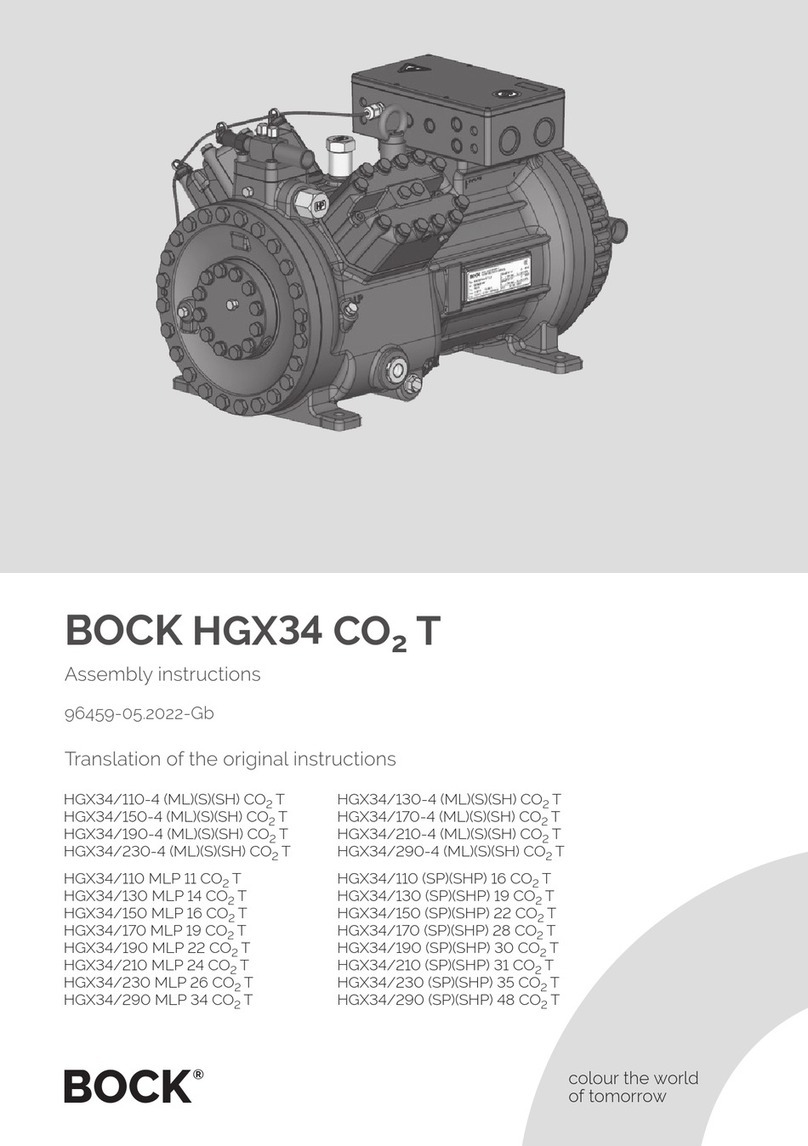
BOCK
BOCK HGX34 CO2 T Assembly instructions

Amber
Amber M32 Installation & maintenance manual
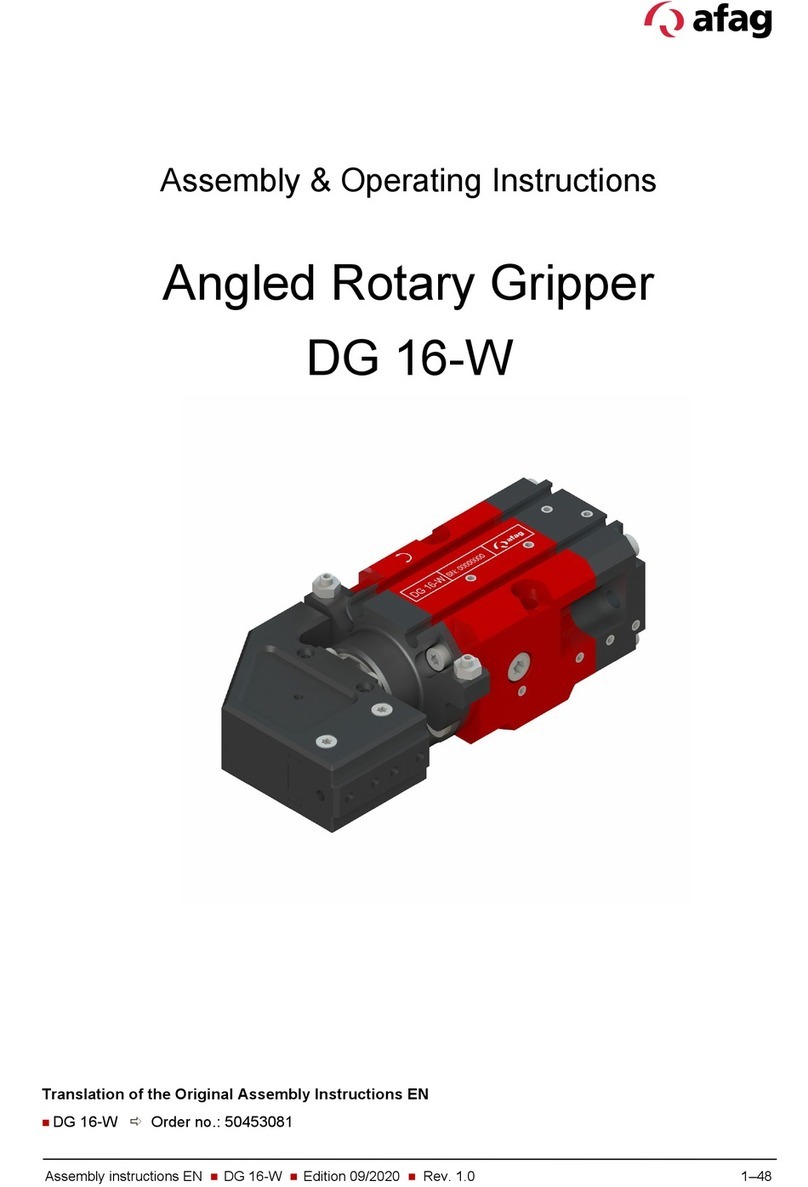
Afag
Afag DG 16-W Assembly & operating instructions
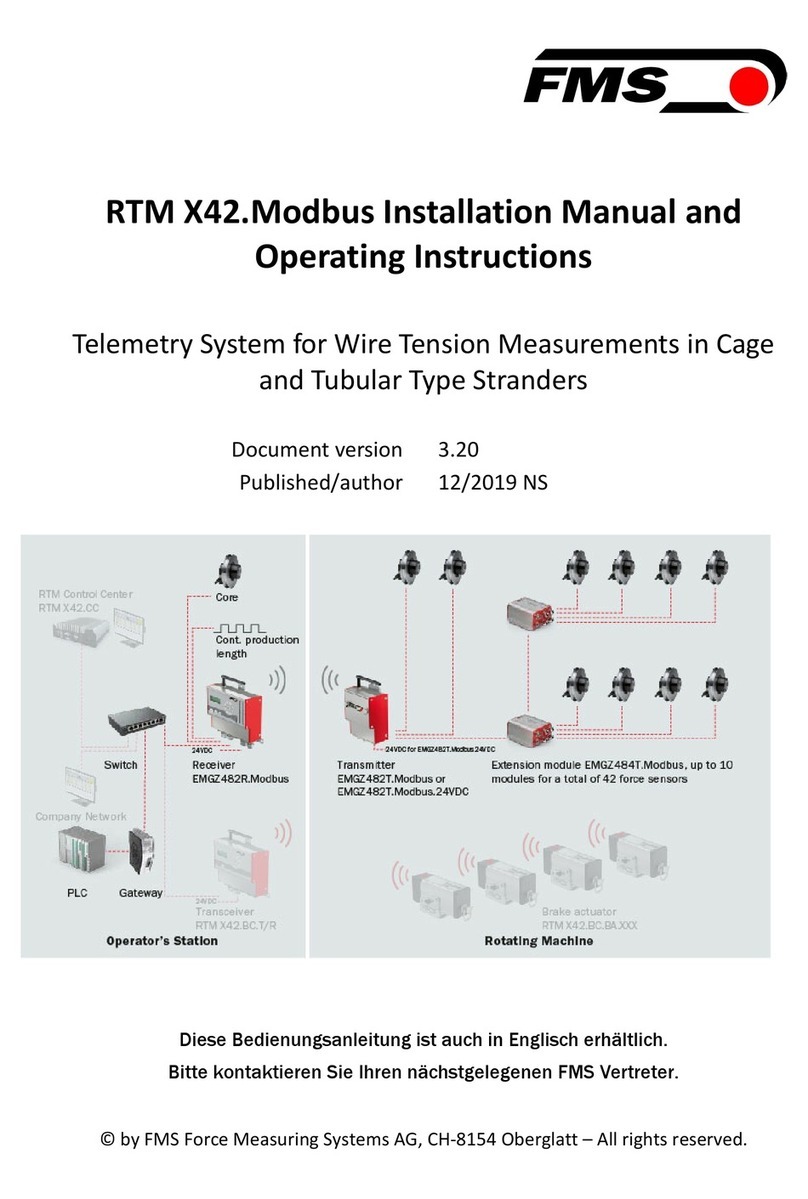
FMS
FMS RTM X42.Modbus Installation manual and operating instructions
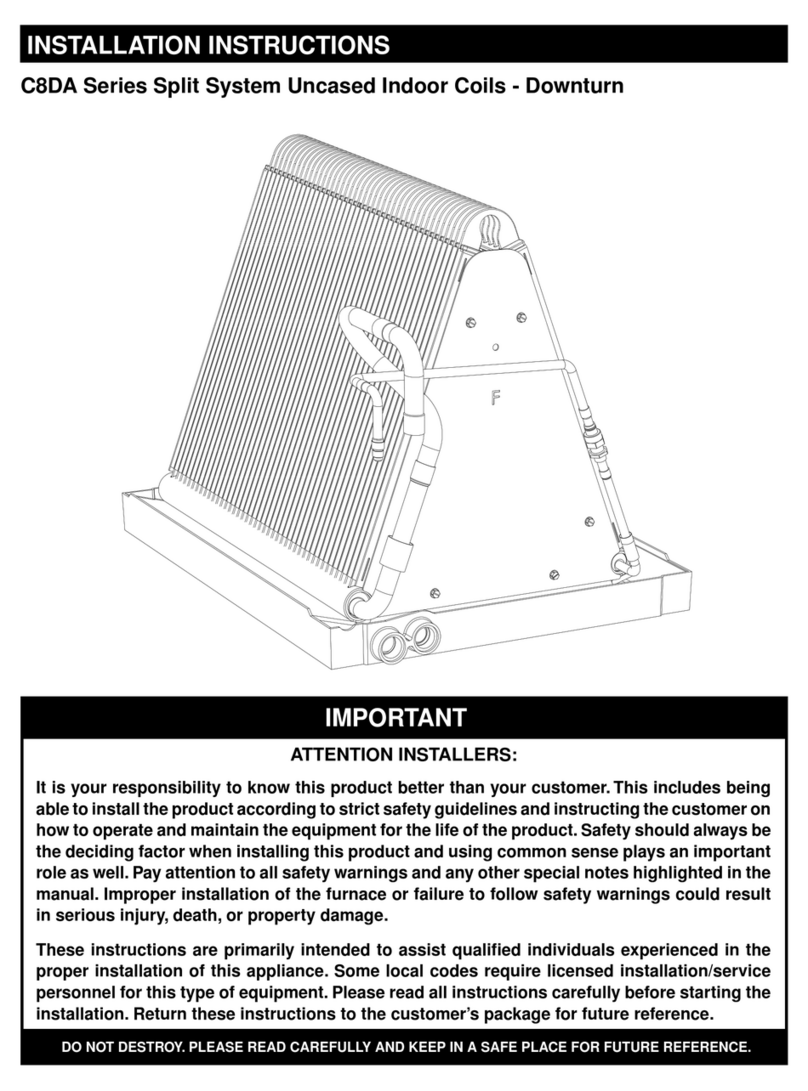
Nordyne
Nordyne C8DA Series installation instructions
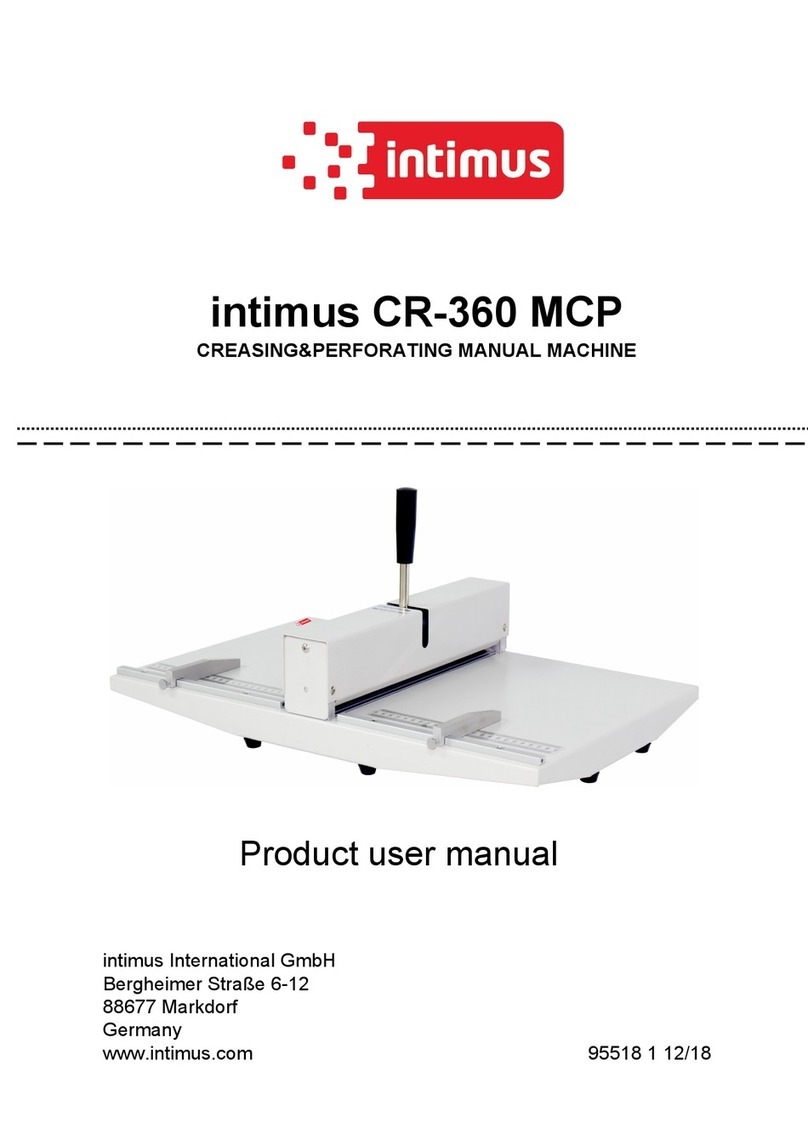
Intimus
Intimus CR-360 MCP Product user manual
